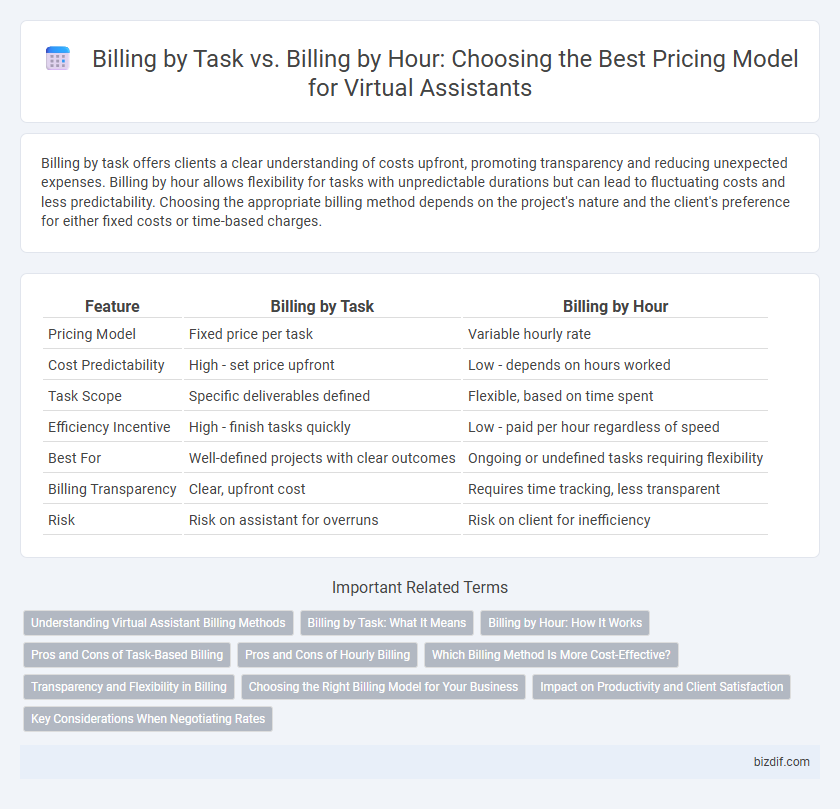Billing by task offers clients a clear understanding of costs upfront, promoting transparency and reducing unexpected expenses. Billing by hour allows flexibility for tasks with unpredictable durations but can lead to fluctuating costs and less predictability. Choosing the appropriate billing method depends on the project's nature and the client's preference for either fixed costs or time-based charges.
Table of Comparison
| Feature | Billing by Task | Billing by Hour |
|---|---|---|
| Pricing Model | Fixed price per task | Variable hourly rate |
| Cost Predictability | High - set price upfront | Low - depends on hours worked |
| Task Scope | Specific deliverables defined | Flexible, based on time spent |
| Efficiency Incentive | High - finish tasks quickly | Low - paid per hour regardless of speed |
| Best For | Well-defined projects with clear outcomes | Ongoing or undefined tasks requiring flexibility |
| Billing Transparency | Clear, upfront cost | Requires time tracking, less transparent |
| Risk | Risk on assistant for overruns | Risk on client for inefficiency |
Understanding Virtual Assistant Billing Methods
Virtual assistant billing methods vary primarily between billing by task and billing by hour, with each approach offering distinct advantages based on project scope and client preferences. Billing by task provides clear cost expectations and efficient budget management for specific deliverables, while billing by hour allows flexibility for dynamic workloads and ongoing support. Understanding these billing frameworks helps clients optimize resource allocation and enhances transparency in virtual assistant services.
Billing by Task: What It Means
Billing by task means charging clients a fixed price for a specific service or project regardless of the time spent, providing clarity and predictability in expenses. This method incentivizes efficiency and results-based work by focusing on deliverables rather than hours logged. Virtual assistants benefit from task-based billing by tailoring pricing to the complexity and value of each assignment, improving client satisfaction and cash flow stability.
Billing by Hour: How It Works
Billing by hour charges clients based on the total time a virtual assistant spends on tasks, tracked precisely using time-tracking software or manual logs. This method ensures transparent invoicing by documenting hours worked, supporting accurate compensation for variable workloads and project complexity. Hourly billing is especially effective for ongoing or unpredictable tasks where the scope and duration fluctuate.
Pros and Cons of Task-Based Billing
Task-based billing offers clear cost expectations by charging a fixed price for specific virtual assistant services, reducing client uncertainty and preventing unexpected expenses. This method encourages efficiency and precise scope definition but may lead to disputes if tasks are not well-defined or if project requirements change, causing potential scope creep. Clients benefit from budget control, while virtual assistants must carefully estimate time and resources to maintain profitability.
Pros and Cons of Hourly Billing
Hourly billing provides precise compensation for the exact time spent on tasks, promoting transparency and fairness between clients and virtual assistants. It enables flexibility for varying workloads but can lead to unpredictable costs and potential inefficiencies if tasks take longer than anticipated. Clients may struggle with budget control, while virtual assistants benefit from payment aligned directly with effort and time invested.
Which Billing Method Is More Cost-Effective?
Billing by task offers a more cost-effective solution for virtual assistants when the scope and deliverables are clearly defined, reducing the risk of paying for unproductive hours. Billing by hour can lead to higher costs if tasks take longer than anticipated, especially in projects with uncertain timelines or frequent changes. Clients seeking budget predictability and outcome-based payments often find task-based billing more advantageous.
Transparency and Flexibility in Billing
Billing by task offers greater transparency by clearly defining costs upfront, allowing clients to know the exact price for each service without hidden fees. Billing by hour provides flexibility to accommodate fluctuating workloads and varying task complexities, ensuring clients pay for the actual time spent. Both methods cater to different project needs, enhancing overall client satisfaction through adaptable billing structures.
Choosing the Right Billing Model for Your Business
Billing by task offers transparent, fixed costs ideal for clearly defined projects, ensuring predictable budgeting and simplifying expense tracking. Billing by hour provides flexibility for evolving or complex assignments where time requirements may fluctuate, allowing adjustments based on effort and scope. Selecting the right billing model hinges on your business's project nature, budget stability, and preference for cost predictability versus adaptability.
Impact on Productivity and Client Satisfaction
Billing by task enhances productivity by providing clear expectations and incentives for timely completion, reducing time spent on administrative tracking and allowing virtual assistants to focus on deliverables. Clients benefit from predictable costs and tangible results, increasing satisfaction through transparency and value alignment. Conversely, billing by hour can lead to inefficiencies with fluctuating time logs and potential disputes over hours worked, which may decrease both productivity and client trust.
Key Considerations When Negotiating Rates
When negotiating rates for virtual assistant services, consider the nature and complexity of tasks to determine whether billing by task or by hour offers better value. Billing by task provides cost predictability for clearly defined deliverables, while hourly billing accommodates flexible workloads and varying task durations. Assess factors such as task frequency, expected turnaround time, and desired budget control to choose the most efficient billing structure.
Billing by task vs Billing by hour Infographic

 bizdif.com
bizdif.com